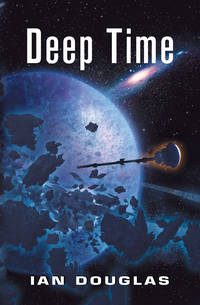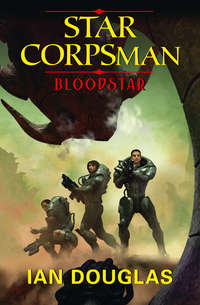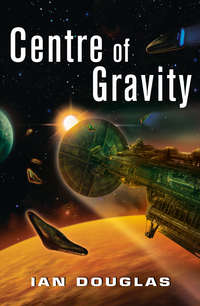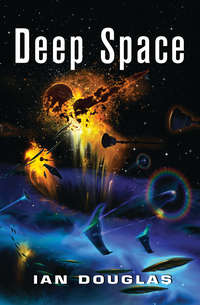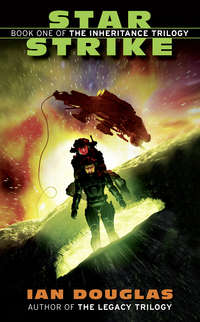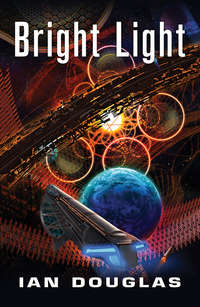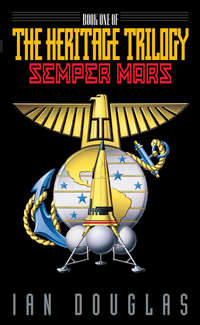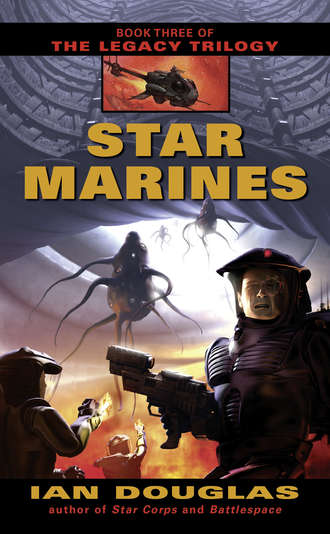
Полная версия
Star Marines
Garroway looked down at the chasm with a certain amount of proprietary fondness. A great-great-several-more-times-great grandfather of his—also a Marine—had led a march up that valley at the onset of the UN War in 2047. “Sands of Mars” Garroway had contributed a bit to the Marine legend, and three centuries later remained one of the major heroes of the Corps’ history, alongside such names as Puller, Basilone, and Ramsey. Travis Garroway enjoyed a certain amount of notoriety in the Corps today, thanks to the exploits of his illustrious ancestor … not to mention the fact that his own uncle was also a Marine, and a major general to boot.
Of course, that notoriety had a downside as well. With a name like Garroway to live up to, there were certain … expectations circulating about his character and his sense of duty, little things like needing to be the first to volunteer to be stuffed inside a shit can and fired out the launch tube of an experimental recon-raider.
That shit can continued its descent, now scarcely thirty kilometers above the gashed-open desert below. Garroway could clearly make out the banded layering of sedimentary rocks along the weathered faces of the cliffs—the final proof, if proof was needed, that Mars once had possessed a vast ocean covering nearly half of its surface and, by extension, an atmosphere thicker than the thin, cold wisp of CO2 that enveloped the planet now.
His mind flicked to the Ancients, the inevitable name for the mysterious and godlike civilization that had tried to terraform Mars half a million years ago—and failed. They’d left traces of their presence on the Red Planet—including evidence that they’d tinkered with the DNA of certain bright and promising primates on the Blue Planet, next in toward the Sun.
And there was evidence, too, that the Ancients’ colony on Mars had been destroyed by another darker, far-ranging interstellar civilization, the so-called Hunters of the Dawn. A robotic ship, nicknamed the Singer, had been discovered beneath the ice of the world-ocean of Europa, one of Jupiter’s moons. Evidently, the Singer had taken part in the destruction of the Ancient colony.
If the Hunters of the Dawn had been limited to the Galactic stage of half a million years ago, that would have been one thing. But it was now known that the Hunters were still out there, somewhere, among the Galaxy’s myriad stars. The Hunters had crushed the reptilian An some eight thousand years ago, destroying the colony they had planted on Earth. And they’d emerged from the huge wedding-band circle known as Sirius C—the Sirian Stargate—to capture a human-crewed starship just a century and a half ago.
The blink of an eye, by the standards of the vast and slowly turning Galaxy.
For that reason, the Marines continued to train, and the science wonks continued to develop new and better and more fearsome military technologies. The Gateway through from Sirius to a nameless star system on the outskirts of the Galaxy had been closed by a Marine expeditionary force in 2170, but few in military circles believed that that had solved the problem. The Hunters of the Dawn were out there, and they now were aware that an upstart technological species known as Homo sapiens was beginning to make its presence felt on the Galactic stage.
Sooner or later, the Hunters would return.
We Who Are
Outer Solar System
0436 hrs, GMT
The Huntership had slipped quietly into the target star system designated 2420-544 on the old records, unseen, undetected, until the system’s star was just over a scant light-hour distant. One of the sources of radio emissions became aware of the Huntership’s approach, and accelerated to intercept. Radio signals and coherent light at a variety of wavelengths reached out from the challenger, evidently seeking communication.
We Who Are deliberated briefly, then extended their consciousness.
The challenger was patterned, its energies recorded, its material structure dispersed. The patterns of the primitive vessel’s occupants—confirmed as Species 2824—were dissected and questioned, all the way down to the quantum level, confirming the stored data on this system’s species acquired recently from other sources.
The Huntership continued on its implacable course inbound.
Assault Detachment Alpha
Above Olympus Mons,
Mars
1236 hrs, local
Atmospheric drag had slowed his velocity to less than a kilometer per second, and the plasma fireball was dissipating. His noumenal display began showing pinpoints of light against the sky and horizon around him—the other IMAC pods in their descent formation, imbedded in a cloud of decoys.
“Okay, boys and girls,” a voice said over his headset. The ID tag identified it as Lieutenant Wilkie, riding Alpha Flight Six and in charge of the drop. “Sound off!”
“Alpha One, copy and acknowledged,” another voice replied.
“Alpha Two, sweet and neat.” That was Chrome.
“Alpha Three, okay,” Garroway replied.
The litany continued down the roster, until all thirty-two pods had checked in. Garroway breathed a bit easier, then. These pods had been endlessly tested for their re-entry capabilities, both in sim and in actual, but there’d still been that lingering, tiny doubt that something, some design flaw, might have been overlooked. But they all had made it past the first hurdle, at least.
“Hey, Chrome,” he called on a private lasercom channel. “Did you get a load of Olympus coming down? Looked like the Solar System’s biggest tit.”
“Roger that, Trigger. But her nipple was an innie, not an outie.”
“Collapsible model, Chrome.”
“Can the chatter, people,” Wilkie said, cutting in. “Verify ECM, and release chaff.”
An alarm sounded in his mind. His pod was being tracked by ground radar. Decoys or not, the pretend enemy on the ground was watching their approach, and had just targeted him.
Not good. Garroway—“Trigger” to the other Marines in Alpha Company—engaged Level One ECM. A thought fired six chaff canisters from the outside hull. The cloud of silvered Mylar expanded around him, mingling with ablative fragments still following the pod’s descent. They might see them coming from the ground, but it would be next to impossible to know what to shoot at.
That was the idea, at least. Part of the Marines’ training involved spending time in a ground fire-control radar center, watching this sort of exercise from the other side. At times like this, it could be comforting to know that the ground techs were seeing an ungodly hash of static on their screens, not the array of sixteen crisp, sharp blips that meant a flight of incoming hostiles.
Minutes more passed. They were twelve kilometers up, and one hundred from the LZ. “Alpha Flight, Alpha Six. Deploy aeroform flight surfaces for landing.”
At a focused thought, portions of Garroway’s pod began unfolding, transforming the cylindrical pod into a blunt-nosed lifting body. The tiny craft shuddered and banged, engaging atmosphere as his rate of descent decreased. His battlesuit AI noted that the flight surfaces had deployed; there would be no need for emergency HALO systems.
Noumenal indicators showed the Oannan drive coming up to power. That was the really scary part of this exercise … working with that alien and poorly understood technology. The amphibian Oannans, or the N’mah, as they called themselves, discovered at the Sirius Stargate a century and a half ago had been working with human scientists ever since, helping them integrate bits and pieces of archeotechnology into a coherent understanding of advanced physics. Humankind had a long way to go on that road, but one bit of early payoff, if the science techs were to be believed, was that long-dreamed-of, long-unachievable Holy Grail of propulsion technology, a reactionless drive.
The Marines’ lives were quite literally riding on the gadget. If the Foureyes’ little wonder child didn’t work as advertised, there shortly would be sixteen fresh, bright, new craters in the Martian desert, and Bravo 2/1 would need to send for newbie replacements from Lejeune, stat.
“Okay, people,” Wilkie’s voice said. Was that nervousness adding a ragged edge to his voice, or just an effect of vibration as his pod slammed into heavier atmosphere? “Nice and easy, just like in the sims. Deploy inertial dampers and engage QRD.”
Inertial dampers switched on, softening the pods’ headlong plummet. They did not completely erase inertia—even the Oannans couldn’t stop their spacecraft on the proverbial dime without deceleration—but they did muffle the occupants from the effects of abrupt, high-speed maneuvering.
Of course, the thirty-two incoming pods no longer responded like dead lumps of metal dropping through atmosphere. Drag now had a much greater effect, slowing their velocity substantially.
And that meant their obscuring cloud of chaff and ablative debris now left them, racing ahead at near-terminal velocity while the pods abruptly slowed. Red light warnings flared in Garroway’s mind. The strike force was now being clearly illuminated by ground-based radar and ladar.
“Alpha Flight, evasive pattern one!” Wilkie shouted over the laser link. “Down on the deck!”
In tight, echelon formation, the flight engaged their Quantum Reactionless Drive units, veering sharply into a near-vertical drop, plunging toward the desert. At fifteen hundred meters they pulled up sharp and hard, arrowing across the blurring ocher surface of the desert. For ninety seconds more, they held to their course, before decelerating hard and descending the final mile to the surface of the desert.
The shock wave of their passage stirred swirling clouds of dust in their wakes. With the Oannan drives on full, they slowed, then slammed into the ground, the shock—most of it, anyway—absorbed by the inertial dampers.
The black hull of Alpha Three split open, folding back on itself, and Garroway emerged, unfolding from an uncomfortable crouch. His armor, coated with chameleonic surfacing, showed the jet black of the pod’s interior, but in seconds had faded to an overall ocher-red, mirroring almost perfectly the surrounding color and shapes of desert and a pink-tinted sky. The Mark XLIV Marine CAS, or Combat Armored Suit, stood just over two meters tall, massive and blocky, a walking tank. A Hawking 34mm chaingun firing high-explosive rounds was mounted on the machine’s right forearm; an A-frame launch unit strapped to the massive back carried three Shrike-C missiles with AI guidance and tactical nuclear warheads, each packing a two-kiloton punch. The suit’s on-board AI unit was smarter than a man, with better speed, better memory, and better focus, though it lacked emotion or a sense of morals, of right and wrong. Kill-no-kill decisions still required a human wired into the decision circuit.
The Mk. XLIV—the “Fighting Forty-four”—was widely viewed in military circles as the endpoint of the evolution of individual combat armor, massive, high-powered, and lethal. Current military doctrine declared that the life expectancy of an unarmored man on the modern battlefield was to be measured in scant seconds, and the Mk. XLIV was intended to extend that lifespan to minutes, even to hours.
At the moment, there were thirty-two Marines in Mk. XLIVs scattered across the desert in a footprint twelve kilometers across. According to satellite nav data, they’d come down precisely on the planned LZ which, if all had worked as planned, put them well inside the opposing force’s perimeter, almost on top of their objective.
“Okay, Marines!” Wilkie called. “Let’s move!”
“Ooh-rah!” Garroway and the other Marines chorused, the ancient war-cry of the Corps.
The formation turned east and began moving, loping across the broken and water-eroded desert floor at a ground-eating five kilometers per hour.
We Who Are
Outer Solar System
0448 hrs, GMT
The Huntership continued its approach to the target world, sensors fully deployed, tasting the radiations and reflections of an immense volume of local space. A second artificial structure was detected, a large one—almost a quarter of the Huntership’s mass—moving in an extended orbit well above the system ecliptic.
Again, We Who Are extended their collective consciousness, almost casually reaching for this new target. …
2
12 FEBRUARY 2314
High Guard Monitor U.E.S. Prometheus
Trans-Saturn Space
1248 hrs, local
In the dark and lonely gulf beyond the orbit of Saturn, one light-hour from a dim and shrunken Sol, the U.E.S. Prometheus maintained her year-long vigil.
During the twenty-first century, during the UN War, an attempt had been made to shift the orbit of a bit of nickel-iron debris in order to bring it down on North America with the destructive impact of many fusion warheads—a single blow to end a savage and expensive war. The attempt had failed—mostly. The wreckage of the spacecraft engaged in the tricky maneuver had come down over Lake Michigan; the ruins of Old Chicago would remain radioactively uninhabitable for a number of centuries yet to come.
Later, as Humankind began exploring its interstellar neighborhood, unsettling discoveries came to light, discoveries to the effect that the galactic predators known as the Hunters of the Dawn used asteroids to destroy promising civilizations, including the Ancients. Exoarcheologists were still exploring the planetwide ruins on Chiron, in the Alpha Centauri system, and believed that the Ancients’ colony on Mars had failed when an asteroid impact there had stripped away much of the artificially induced atmosphere. The An colony on Earth eight millennia ago—and the nascent human civilization that served as their slaves—had been wiped out by a small asteroid dropped into what was now the Arabian Gulf.
Evidently, when it came to planet-wrecking, asteroids were the long-established weapon of choice.
To ensure that asteroids never again were used as weapons against Earth—by that world’s warring civilizations or by anyone else—the old Federal Republic of America had established the High Guard, a fleet of large warships patrolling through the emptiness from the Asteroid Belt out to beyond Saturn, tracking and monitoring all spacecraft moving into that immense zone.
The U.E. monitor Prometheus was one of the largest of the modern High Guard vessels, half a kilometer long, with a crew—Navy, Marine, and civilian—of almost three thousand. Mounting powerful batteries of high-energy lasers, missile batteries, and railgun-launched antimatter warheads, surrounded by a vast and far-flung cloud of robotic sensors, drones, and manned fighters, Prometheus was slow, but arguably the most powerful warship in the military inventory of the United Earth.
Much of the monitor’s crew was in nanosuspension, the better to conserve limited expendables like food, water, and air. At any given time, a quarter of her crew was awake and functioning; Blue Watch had the duty now.
Sensor Technician Third Class Baldwin drifted within a sphere of night, star-dusted, with brighter points of colored light marking the positions of Prometheus’s drones and patrols, of Deep System Station 39, and of Saturn, now some thirteen million kilometers to spinward. His noumenal link connected him with the assembled sensory data from all of Prometheus’s remote drones and fighters.
And there was nothing, nothing out there to threaten the almost meditational calm of the watch.
Watchstanding on a High Guard monitor generally was the very definition of the word boredom. The United Earth had been at peace now—for perhaps the first time in its recent history—for the past eighty years. The last of Earth’s wars, the abortive Central Asian Jihad of 2234, had ended almost before it had begun, and had been limited entirely to ground-based forces. The thought that anybody now possessed the technology to challenge either the U.E. or the American Confederation that dominated that world body in space—much less launch an attack from the Outer System—was laughable. In fact, more and more political voices on Earth had been calling for an end to the High Guard, for so long a frightfully expensive relic of a long-past threat.
The politicians could argue; in the meantime, the Navy continued its patrols. Tradition would be, must be, maintained. It was the Navy way.
ST/3 Baldwin first noticed something was happening when the monitor’s AI called his attention to an anomaly—a burst of high energy radiation arriving from the direction of the constellation Canis Major, close by the bright beacon of Alpha Canis Majoris—Sirius. Sensor drones in that direction responded an instant later, reporting a sizeable mass approaching at .95c.
“What the hell?” Baldwin asked, addressing no one in particular.
“Contact appears to be a ship,” Prometheus’s artificial intelligence told him. “Type unknown, propulsion system unknown, origin unknown.”
“Sound the contact alert,” Baldwin snapped. “Get the skipper on-line!”
“Whatcha got, Baldie?” the captain’s voice asked in his mind a heartbeat later.
“I don’t know, sir,” he replied. “Whatever it is, it’s big … and it’s coming in at near-c, right behind its dopplered wavefront.”
That was the trouble with sensor systems limited to the speed of light. If your target was approaching you at close to that velocity, you had damned little warning of the approach.
And then, the contact was there—huge, gleaming gold, needle-slender but easily packing the mass of four Titan-class High Guard monitors. It decelerated from close to light-speed to almost motionless relative to the Prometheus, hanging there in the black emptiness a scant hundred kilometers away.
“Christ and Krishna!” Captain O’Mallory rasped. Baldwin felt him trigger the dispatch release, transmitting the details of the encounter so far Earthward.
Baldwin had seen records of an identical vessel—the mile-long needle that had emerged from the Sirian Stargate over a century and a half ago to snatch up the exploratory vessel Wings of Isis, and then emerged again in 2170—or had it been a different ship? Whether the same or different, the monster intruder, positively identified as belonging to the near-mythical Hunters of the Dawn, had been destroyed in the fierce-fought Battle of Sirius.
The Hunters of the Dawn, the Xul of ancient Sumerian legend, had returned.
An instant later, Baldwin began screaming as the quantum reality ground state patterns of the Prometheus, and every soul on board her, were wrenched from material existence. The transformation took only a few seconds.
From ST/3 Baldwin’s perspective, however, the shrieking tortures of Hell engulfed him, the agony of discorporation going on … and on … and on …
Assault Detachment Alpha
Eos Chasma,
Mars
1410 hrs, local
Assault Detachment Alpha was nearly in position for the attack. They’d worked their way up a low range of rugged, eroded hills east of the LZ, and were looking down now on an enormous military base, sprawling towers, a large spaceport, and hectare upon neatly ordered hectare of warehousing. Most of the target was all in their heads—a noumenon conjured within their minds, as opposed to a phenomenon, existing in the world around them. The only material opposition were their human counterparts in this war game, Army Special Forces playing the role of OPFOR.
Still the training AI monitoring the operation was keeping track of both sides, tallying fire, casualties, and damage, even while painting the illusion of the sprawling military base in the minds of all of the human participants.
There’d been no fire yet, and no casualties on either side. The landing, much closer to the target than expected, had caught OPFOR by surprise. Space-suited figures were spilling from the image of pressurized bunkers to meet the Marines, but Assault Detachment Alpha had already grabbed the high ground. There weren’t many of them, either … only a company or so, perhaps fifty men. The rest must have already deployed deep into the desert, bypassed by Alpha’s pinpoint drop.
Garroway grinned behind the opaque shield of his helmet visor as the enemy streamed into the open below, racing for the high ground and straight into Alpha’s sights. It was going to be a slaughter—at least the way computers tallied things.
He ratcheted back the charging lever on his primary weapon, charging the Hawking. The ammunition load he was carrying was training ordnance, of course, but it would still make a most satisfying pyrotechnic display.
“A-D Alpha, Alpha Six,” Wilkie’s voice said over the net. “Let’s take ’em! …”
“Alpha Detachment, this is Stickney Base. Stand down. The exercise is terminated.”
“What the fuck?” Garroway looked up into the Martian sky—a deep ultramarine overhead, shading toward dusty pink near the horizon. Actually, Phobos was not above the horizon at the moment, though it would be soon. The tiny, potato-shaped moon orbited Mars in less than eight hours, rising in the west and setting in the east only five and a half hours later. But he stared up, anyway, as if to drag down from the sky some reason for the incomprehensible command. “What the hell’s going on?”
“All right, Marines, you heard the order,” Lieutenant Wilkie said. He stood up, sand spilling from his combat armor as its surface rippled with the rust and ocher hues of its chameleonic display. “Safe your weapons!”
In the valley below, the magical city of towers, warehouses, and bunkers shimmered and faded from view. In its place, a pair of pressure domes remained, along with a few dozen black-armored Special Forces troopers.
In single file, the Marine element began trudging down the hillside toward the waiting soldiers.
“Hey, Marines,” one of their former enemies called, raising a massively gauntleted hand. His words were light, bantering. “We were gonna kick your asses!”
“Ah, you guys were already dead,” Lance Corporal Annette DeVries said. “We had you in our sights!”
“Yeah?” another SpecFor soldier said. “We were just suckering you in, jarheads. We had two more companies out in the desert, closing on you from all sides.”
“That would have put you right where we wanted you, doggie,” Chrome observed. “We could’ve shot in every direction without hitting our own guys.”
“Quiet down, quiet down,” Wilkie ordered. “Save it. A couple of transports are inbound to haul us back to base.”
“So why the cancellation of the fun and games, Lieutenant?” Garroway asked. “Things were just getting interesting.”
“You’ll be told what you need to know when you need to know it, Gunny. Now get your ass in gear and move it!”
Garroway scowled at the back of the officer’s helmet, just ahead of him in the file. Wilkie was a newbie to Bravo Company, fresh out of Annapolis, and hadn’t yet learned the difference between leadership and bullying. Fresh meat. It would be the job of the platoon’s senior NCOs—meaning him and Chrome—to get the guy squared away.
And if he didn’t square, well, there were ways of dealing with that, too. Gentle ways, but ways. A company commander learned to work with his NCOs, his most experienced people, or he found himself transferred to a less life-and-death-oriented billet.
The fact remained, something was happening to upset the brass. He turned and looked back toward the western horizon again, where low, dun-colored hills stood out in crisp relief against the dust-laden sky. Phobos was just now rising—a tiny, misshapen disk, moving swiftly enough that he could actually track its movement by eye.


